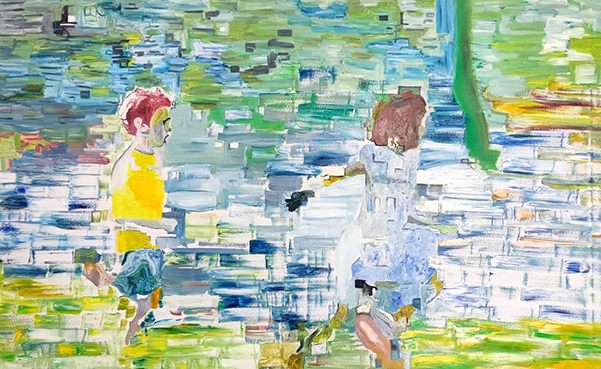Art, with its ever-evolving nature, has the incredible ability to encapsulate an artist’s journey and inner exploration. Franck Alagna, an artist in the contemporary art scene, has harmoniously fused his childhood inspirations, artistic influences, and a unique technique to create a body of work that stands as a testament to his creative evolution.
Alagna’s artistic inclination was ignited during his early years, inspired by the paintings of his father. Those vivid strokes on the canvas became a gateway to his passion, setting the stage for a lifelong pursuit of artistic expression. However, it was his encounter with André Masson during his teenage years that became a pivotal moment of introspection. This encounter prompted Alagna to delve deeper into the realm of art, nurturing a thought-provoking approach that would shape his future works.
As Alagna embarked on his artistic journey, he found himself grappling with questions that every artist confronts – questions about the very essence of art, its purpose, and the means of conveying ideas through the canvas. These contemplations paved the way for extensive painting practice, a period marked by dedication and experimentation. It was during this phase that Alagna stumbled upon a novel technique that would become his artistic signature – the intricate interplay of lines, small squares reminiscent of “pixels,” and colors.
This innovative technique enabled Alagna to traverse the boundary between figurative and abstract art seamlessly. The transition was liberating, allowing him to articulate stories and evoke emotions in ways that conventional forms of expression couldn’t achieve. The canvas, once a mere surface for color, became a playground for stories, where each stroke represented a moment, an idea, or a feeling.

A notable piece in Alagna’s portfolio is “La saxophoniste.” This 125 x 89 cm oil painting on canvas, represented by Ri Galerie, exemplifies his dynamic creative process. The artwork’s essence lies not in conforming to a predetermined vision, but rather in the utilization of color as a vehicle of expression. Alagna’s approach, often labeled as Modern Dynamic Painting, transcends traditional norms, celebrating the diverse ways in which colors and passages can be harnessed to create visual and emotional impact.

“Les enfants courant dans le jardin,” another intriguing creation measuring 146 x 90 cm, showcases Alagna’s penchant for juxtaposition. This oil painting on canvas, also represented by Ri Galerie, explores the interplay of contrasting elements. The juxtaposition of colors, mixes, dynamic elements, and figurative nuances creates a tapestry that bridges historical influences with contemporary aesthetics. Alagna’s ability to unite disparate elements into a harmonious whole is a testament to his artistic finesse.
The concept of juxtaposition, as seen in “Les enfants courant dans le jardin,” is not only a display of visual contrast but also an exploration of broader themes. It invites viewers to engage with scenarios and contrasts drawn from daily life and literature, reflecting the multifaceted nature of existence. The historical and modern aspects coexist, each contributing to the narrative while complementing the other.
Franck Alagna’s journey through the art world is a story of exploration, innovation, and a relentless quest for aesthetics. His ability to seamlessly merge the figurative with the abstract, employing techniques that evoke emotions beyond the limitations of words, is a testament to his skill and dedication. Alagna’s unique technique, which involves the meticulous arrangement of lines and “pixel-like” squares, gives his work a distinct identity that bridges the gap between tradition and modernity.
In a world where artistic expression continuously evolves, Franck Alagna stands as an artist who has harnessed the power of colors, forms, and techniques to communicate stories that resonate with the human experience. His works transcend the canvas, inviting viewers to embark on a journey of contemplation, introspection, and appreciation for the boundless possibilities of artistic expression. As Alagna’s art continues to evolve, it is a testament to the timeless nature of creativity, forever flowing and adapting, much like the artist himself.
